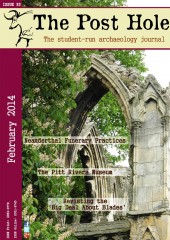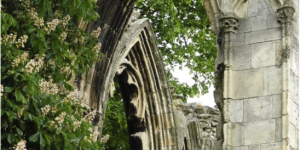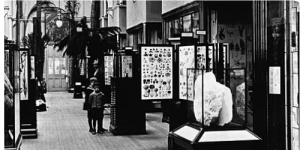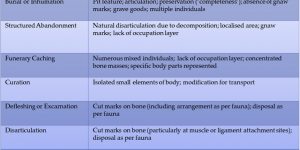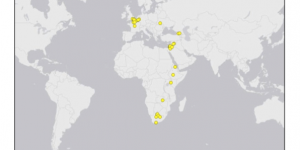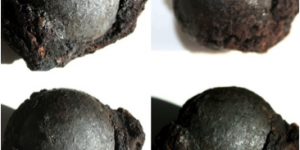During last term, I studied a module on ancient DNA. As a third year BA student at the University of York, and one who had hated science at school, it was a huge step into the unknown. However, despite all that I learnt about science and its applications during the term, the main, and perhaps most important lesson I took away from the term’s work was this: archaeology needs to be more multidisciplinary, and work harder to make links with other fields. In the lectures and seminars over the term, I heard and read much about the ways in which archaeology and other sciences can, and have, worked together on a variety of subjects. The reading that I undertook while studying this module emphasized the importance of a multidisciplinary approach to ancient DNA studies, and it was obvious why. Seeing how techniques devised by those in other fields, such as biologists and geneticists, have been used to great success in archaeological studies, was inspiring. In cases where such integrative methodologies were undertaken, the conclusions reached were all the stronger for it.
However, it seems peculiar that this view is not more widely shared, or, at the very least, that it is not more widely discussed in other areas of archaeology. Much of the literature relating to archaeological science seems to make more of an effort to include the discussion of multidisciplinary methodologies than other areas, and to advocate a multidisciplinary approach (Araújo and Ferreira 2000, 89; Buikstra 2010, 407; Buzon 2012, 60; Dittmar 2009, 365; Wright and Yoder 2003, 56; Zimmerman 2012, 154). And while there do appear to be some less scientific archaeological books involving a multidisciplinary approach, these are few and far between. Having a quick look through the dozen or so archaeology books scattered around me right now, the term ‘multidisciplinary’ (as well as its oft-used peer, ‘interdisciplinary’) doesn’t appear in the vast majority. In fact, the only book in which it does appear is Trigger’s 700-page A History of Archaeological Thought (2006) – although even then, it is only mentioned in a couple of paragraphs.
This just isn’t sufficient. We need to acknowledge that there are limitations to what can be achieved without the help of other fields, whether they be history or biology, classics or pathology. These fields can provide support to existing conclusions or challenge those which are erroneous (Trigger 2006, 514). The best way to prove our findings is to have them challenged, and other fields have the ability to do this, with their expert knowledge on particular subjects that have a link with archaeology.
It could be argued that archaeology must be, at its core, a multidisciplinary subject. We must work together with other fields and disciplines in order to improve our understanding of various topics, but also our understanding of archaeology as a whole. If we challenge and aid one another through multidisciplinary research, we can improve the conclusions we make, but more importantly the way in which we make said conclusions.
However, multidisciplinary links could be taken even further. Many authors have argued that archaeologists need to be trained in a wider variety of subjects, be they in other sciences or in ethical and legal matters (Gillespie 2004, 15-16; Schroeder 2009, 169), not just to improve the academic side of archaeology, but also to prepare them for the working world of archaeology. A rounded educational system for archaeology would enable this to be achieved. Better links between different departments at universities would be the first step towards this, encouraged by the choice to take elective modules in other departments. This would allow students to widen their own knowledge whilst simultaneously considering the links between archaeology and other fields.
In order to move forward as a field, we need to constantly assess our discipline and ourselves, and look at where improvements can be made. One important improvement, I believe, comes from considering a more multidisciplinary archaeology. Advocating a multidisciplinary approach has the potential to improve the skills and techniques used by those within archaeology and similar fields, which in turn would improve the field of archaeology itself. And while some might argue that this is too difficult, why should that stop us?
Bibliography
- Araújo, A. and Ferreira, L.F. (2000) ‘Paleoparasitology and the antiquity of human host-parasite relationships’. Mem. Inst. Oswaldo Cruz. 95 (01). 89-93
- Buikstra, J.E. (2010) ‘Paleopathology: a contemporary perspective’, in L. C. Spencer (ed.) A companion to biological anthropology. Malden: Wiley-Blackwell. 395-411
- Buzon, M. R. (2012) ‘The bioarchaeological approach to paleopathology’, in A. L. Grauer (ed.) A companion to paleopathology. Chichester: Wiley-Blackwell. 58-75
- Dittmar, K. (2009) ‘Old parasites for a new world: the future of paleoparasitological research. A review’. The Journal of Parasitology. 95 (02). 365-371
- Gillespie, S. D. (2004) ‘Training the next generation of academic archaeologists: the impact of disciplinary fragmentation on students’. The SAA Archaeological Record. 4 (02). 13-18
- Schroeder, S. (2009) ‘Thinking about a public and multidisciplinary archaeology’. Reviews in Anthropology. 38. 166-194
- Trigger, B. G. (2006) A history of archaeological thought. 2nd edn. New York: Cambridge University Press
- Wright, L. E. and Yoder, C. J. (2003) ‘Recent progress in bioarchaeology: approaches to the osteological paradox’. Journal of Archaeological Research. 11 (01). 43-70
- Zimmerman, M. R. (2012) ‘The analysis and interpretation of mummified remains’, in A. L. Grauer (ed.) A companion to paleopathology. Chichester: Wiley-Blackwell. 152-169


